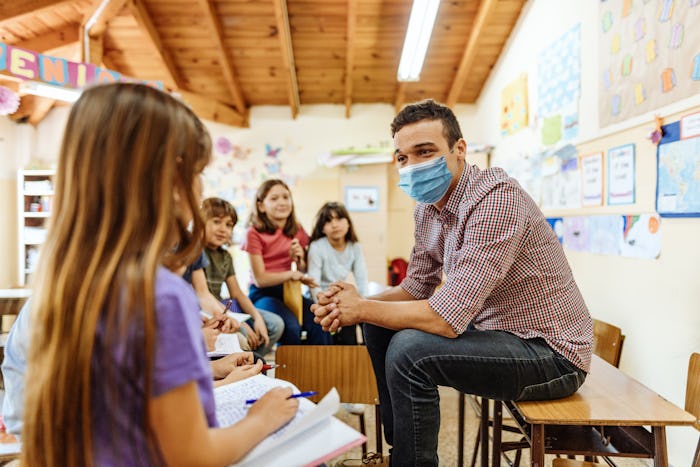Life

Masks Will Make Teachers' Jobs Harder, Educators Explain
Throughout the COVID-19 pandemic, schools have remained closed. But looking ahead to re-opening safely in the fall, mask-wearing in schools is definitely on the horizon. It is yet to be seen how things will play out, but educators seem to agree on one thing: Masks will make teachers' jobs harder.
The American Academy of Pediatrics (AAP) recommends that students resume in-person instruction this fall. However, in compliance with recommendations from the Centers for Disease Control and Prevention (CDC), the AAP also included in their interim guidance for school re-opening recommendations for mask-wearing, which varies by age and priority level. Their guidance does acknowledge the challenges that some students and teachers will face.
"For certain populations, the use of cloth face coverings by teachers may impede the education process," the AAP guidance reads. "These include students who are deaf or hard of hearing, students receiving speech/language services, young students in early education programs, and English-language learners. Although there are products (eg, face coverings with clear panels in the front) to facilitate their use among these populations, these may not be available in all settings."
The question at this point isn't whether or not masks should be worn to keep students and staff healthy, but rather how teachers can do their jobs well while wearing a mask and helping ensure kids keep theirs on. Furthermore, can students learn properly from a teacher wearing a mask, or while wearing one themselves? All are valid questions with extremely fuzzy answers.
For high school teachers like Mackenzie McCall, the mere thought of trying to enforce this new normal can feel daunting. "Last year we implemented wearing student IDs around our neck on a lanyard," McCall tells Romper. "Most of the students didn't comply. How will we enforce masks? Are we even legally allowed to?"
Although direct guidance may come from individual schools, districts, or state entities for how to keep kids wearing their masks, unfortunately, enforcing mask-wearing will likely fall squarely on the shoulders of teachers themselves. As several teachers and parents have already surmised on social media, will masks be this year's version of the dreaded fidget spinner?
Ninth grade biology teacher Jaime Bohon echoes concerns about enforceability, as well as the ability of low-income students accessing masks. "I have many kids who are low-income and many days can't even wash clothes to have something clean to wear," she says, pointing out that some students may not have the resources to keep reusable masks washed after each use. "Every year I have to help kids with school supplies out of my own pocket. I don't think I can afford to supply kids with a mask on top of the school supplies."
Additionally, Bohon expresses concern over her students' ability to hear her with a mask on. "I do worry about talking loud enough with one on for the back of my class to hear me."
Another facet of the mask-wearing conundrum lies with teachers of students who speak English as a second language. As a high school language acquisition teacher in Texas, Casey Smith tells Romper that masks could significantly impede learning for English as a Second Language (ESL) students. "Much of the communication in a beginner ESL classroom relies on visual cues and facial expressions that can be difficult to express behind a mask," she says. "The physical barrier added to the already present language barrier could be overwhelming for some students."
Not all schools will require masks to be worn, however. For example, the Iowa Department of Education released a statement on June 26 that reads in part, "The Department of Education and the Iowa Department of Public Health do not recommend that districts and nonpublic schools require masks for all students and staff because of the considerable implications for such a policy."
Alternatively, clear face shields may be provided by some educational agencies for teachers (such as the one million shields recently purchased by the Texas Education Agency for distribution to teachers), but the expense of purchasing enough face shields can be monumental, and not every state or district can afford this.
Some of the potential issues that mask-wearing could cause have remedies, of course. For example, Smith suggests incorporating pre-recorded videos of teachers for ESL students as one possible solution. Other teachers have touted the idea of clear masks for students or teachers with hearing disabilities. However, when it comes down to it, there is one aspect of teaching that isn't as easily remedied — connection.
"A huge part of a teacher's ability to be effective is how they relate to their students and build trust," Amanda Wakefield, a campus instructional coach at a Texas high school tells Romper. "Our society needs facial cues, like smiles, that we are used to seeing to help us build those relationships. I think it will be much harder for teachers to gain the trust/relationship needed when wearing a mask and social distancing.
"Students aren't used to determining a teacher's mood by just their eyes — teachers can't come close or check a student's work or monitor the classroom from 6 feet away," Wakefield continues. "And without relationships, you can't really be the best teacher."
If you think you’re showing symptoms of coronavirus, which include fever, shortness of breath, and cough, call your doctor before going to get tested. If you’re anxious about the virus’s spread in your community, visit the CDC for up-to-date information and resources, or seek out mental health support. You can find all of Romper’s parents + coronavirus coverage here.
This article was originally published on